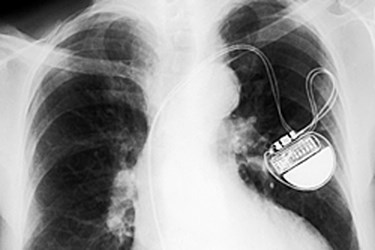Battery-Free Pacemakers Are Powered By Patient's Heartbeat

Technology from the University of Buffalo has joined an international race to develop a pacemaker that is self-powered by harnessing energy generated by the patient’s heartbeat. This next step towards making the devices smaller and more self-sufficient reduces patient risk and inconvenience, claim the researchers.
Since its introduction in 1960, the pacemaker has undergone many makeovers. Competing medical device developers have worked to make the technology as small as possible and to extend the life of its battery. Traditionally, pacemakers have regulated heart beats through wire leads attached to the heart’s tissue, but a study published in The New England Journal of Medicine in September demonstrated promising early findings for a pacemaker that is completely wire-free.
Next-generation pacemakers — say scientists — will seek to do away with the battery as well. Patients fitted with pacemakers often live with the implant for years, if not decades. But, even the most sophisticated battery will have to be replaced at some point, a process that requires painful and risky surgery. By doing away with the battery, researchers believe they can do away with unnecessary patient suffering.
Recent developments in battery-free devices, which harvest energy from environmental motion or static, have yielded a crop of new technology from hearing aids to wearable textiles that soak up energy to power their electrical systems. Now, research institutions around the globe are looking to develop a piezoelectric system that can fit on a pacemaker.
In January 2014, the European Union (EU) awarded $6.7 million to Tyndall National Institute at University College Cork in Ireland to fund its exploration of a pacemaker that could use energy from heartbeats to power itself, and in June, the Korea Advanced Institute of Science and Technology (KAIST) announced it had developed an energy harvesting device compatible with the energy needs of a pacemaker.
The newest entrant to the race is Amin Karami, a professor of mechanical and aerospace engineering at the University of Buffalo, who is working with his team to develop a piezoelectric system small enough to fit the newly introduced wireless pacemaker.
“We are going for the next generation of device, leadless pacemakers. Leadless pacemakers are grain rice sized devices which go right in the heart without any leads or attachments,” said Karami in a video.
Because the leadless pacemakers are so small, Karami noted that they’re especially difficult to power. “The technology we have developed — because it is in the heart and the heart is moving so vigorously — is superior to the batteries because it can safely and robustly power the pacemaker for the entire lifetime of the patient.”
According to University of Buffalo’s News Center, Karami is working with device makers to develop a prototype and expects to start animal testing within two years.
